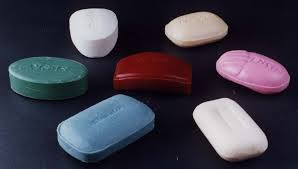
1.4 million deaths can be prevented each year by hand washing with soap.
7 million children have died due to disease that could have been prevented with proper hygiene since 2009.
Children under 5 who wash with soap can reduce their risk of pneumonia by 50%.
The World Health Organization and the Centers for Disease Control actively promote handwashing to save lives by preventing illness and infectious diseases.
Handwashing with soap is among the most effective and inexpensive ways to prevent diarrheal diseases and pneumonia, which together account for 3.5 million child deaths annually.
Soap was first used as a medicinal agent.
The Egyptians regularly bathed, using a soap made by combining animal fats with wood ash.
Real soap is created by combining a strong alkali (lye) with oils and fats.
Real soap made with natural ingredients often has a healing effect on acne, eczema, psoriasis and other skin conditions.”
The soapmaking process, called “saponification,” separates the oils’ fatty acid bonds and combines them with molecules in the lye to form a salt. This salt is what we refer to as “soap.” (Yes. Not all salts are hard.)
Most commercial soaps are not true soap, but are a combination of chemical detergents, artificial lathering agents and toxic chemicals.
After a perfectly balanced saponification process finishes, the soap no longer contains lye or fat. Both are “consumed” during the saponification process.
The best soapmakers add extra oils to their recipes. Doing so means that some of the oils do not saponify and remain in the soap. This is called “superfatting” and creates a very moisturizing, nourishing bar of soap.
Glycerin, a natural moisturizer, is a natural product created during the soapmaking process. Commercial soap manufacturers remove the glycerin, replacing it with artificial detergents and other chemicals. This creates a soap that is very drying to the skin.
A single bar of commercial bar soap may contain over 20 toxic ingredients, many of which have been connected to cancer, endocrine issues, skin problems and more.
The lather, hardness and moisturizing qualities of a soap are dependent on the various oils used in the recipe.
A simple, moisturizing soap can be made using nothing more than olive oil, lard and lye. This soap can be made using common kitchen equipment. Nothing special is needed!
Handwashing by birth attendants before delivery reduces mortality rates by 19%.
Handwashing with soap can reduce diarrhea morbidity by 44%.
1/3 of the worlds soap is used by the U.S.
10 Billion pounds of soap are produced each year.
Murphy’s Oil Soap is used to clean elephants.
The average person encounters 100 chemicals before breakfast.
We absorb 60% of the substances we put on our skin.
Ivory Soap was designed not to float.
There are 4.6 million hotel rooms in the U.S.
2.6 million bars of soap are discarded daily by the hotel industry in the U.S. alone.
The largest soap bubble was created on October 9th, 2005 and measured 105.4 cubic feet. If you could fill it with baseballs it would hold 13.627 of them.
October 15th is Global Handwashing Day.
Soap FAQs: Unveiling the Secrets of Sudsy Companions
Soap, that ubiquitous bar in our showers and dispensers, is a cleaning marvel with a long history. But have you ever stopped to wonder how it works, what it’s made of, or if there’s a difference between soap and those fancy body washes? Fear not, for this FAQ dives deep into the world of soap!
1. What exactly is soap?
Soap is a product formed through a chemical reaction called saponification. In simpler terms, it’s the result of combining fats or oils with a strong alkali, like lye. This process creates a molecule with a unique structure: one end loves water (hydrophilic), while the other end loves oil and dirt (hydrophobic). This duality is key to soap’s cleaning power.
2. So how does soap clean?
Imagine soap molecules as little magnets. The oil-loving end attaches to dirt and grime, while the water-loving end bonds with water. When you rinse with water, the soap molecules, along with the attached dirt, are washed away.
3. Is there a difference between soap and body wash?
There can be! Traditional soap is primarily made from fatty acids and alkali salts, while body washes can be a mix of synthetic detergents, surfactants, and various other ingredients. These additional ingredients can provide features like lathering, moisturizing, or specific scents.
4. Are all soaps created equal?
Not quite! Soap can be made with various fats and oils, each offering unique properties. For example, olive oil soap is known for being gentle, while coconut oil soap creates a rich lather. Additionally, soaps can be formulated with specific needs in mind. There are soaps for sensitive skin, moisturizing soaps, and even exfoliating ones.
5. I heard about lye in soap making, is that dangerous?
Lye is a strong alkali and can be dangerous if not handled properly. However, in the soap-making process, lye undergoes a chemical reaction with fats/oils and is no longer present in the final soap product. So, the soap you use in your shower is perfectly safe.
6. Are antibacterial soaps better?
Antibacterial soaps might kill some bacteria, but they’re not a magic bullet. Regular soap and water are very effective at removing germs and dirt for most everyday situations. Overuse of antibacterial soaps can disrupt the natural balance of bacteria on your skin and potentially contribute to antibiotic resistance.
7. How can I make soap last longer?
Here are some tips for extending the life of your soap:
- Store it dry: Avoid leaving your soap in a constantly wet dish. Use a well-draining soap dish that allows water to run off.
- Cut it up: If you have a large bar of soap, cut it into smaller pieces. This exposes less surface area to moisture and allows it to dry faster between uses.
- Keep it cool: Avoid storing soap in direct sunlight or hot, humid environments.
8. What about those fancy, clear melt-and-pour soap bases?
These are pre-made soap bases that have already undergone saponification. They’re a great option for beginners or those who want to customize soap with colors, fragrances, and other additives.
9. Is there a way to tell if my soap is natural?
Look for keywords like “handmade” or “cold process” on the label. These soaps are typically made with natural ingredients and traditional methods. You can also check for certifications from organizations that promote natural products.
10. I have sensitive skin, what kind of soap should I use?
If you have sensitive skin, opt for gentle soaps made with natural ingredients and free of harsh fragrances or dyes. Look for soaps made with olive oil, shea butter, or goat milk, which are known for being mild.
11. Can soap be bad for the environment?
Some soaps, particularly those containing palm oil or harsh chemicals, can have environmental consequences. Look for soaps made with sustainable palm oil or plant-based alternatives. Additionally, opt for soaps with minimal packaging to reduce waste.
By understanding the science behind soap and the different options available, you can choose the perfect bar to keep you clean and happy!









